ASUS UX31A: Putting the Ultra in Ultrabooks
by Jarred Walton on August 28, 2012 9:00 AM EST- Posted in
- Laptops
- Intel
- Asus
- Ivy Bridge
- Zenbook Prime
- Ultrabook
ASUS UX31A: General Performance
Next up is our overview of general performance, and honestly outside of the laptop overview and LCD characteristics this is probably the most pertinent aspect of how the UX31A behaves in everyday use. You typically don’t buy an Ultrabook because you want the fastest laptop on the planet or for serious gaming. Those duties are for larger laptops that can house discrete GPUs and quad-core processors. Ultrabooks are about portability and everyday tasks like running Office, surfing the Internet, checking email, etc.—only they’re hopefully more responsive than regular laptops thanks to their SSDs. Here’s how the UX31A compares to other recently reviewed Ultrabooks, including the prototype Ivy Bridge Ultrabook from Intel.
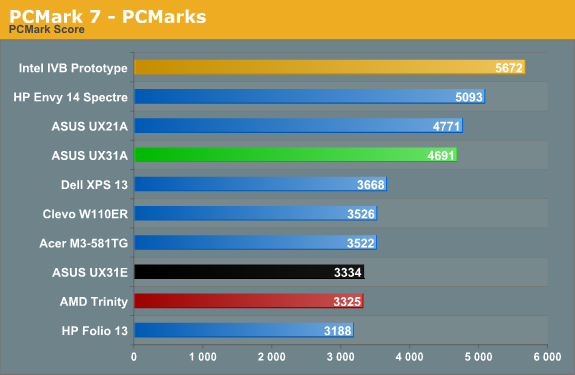
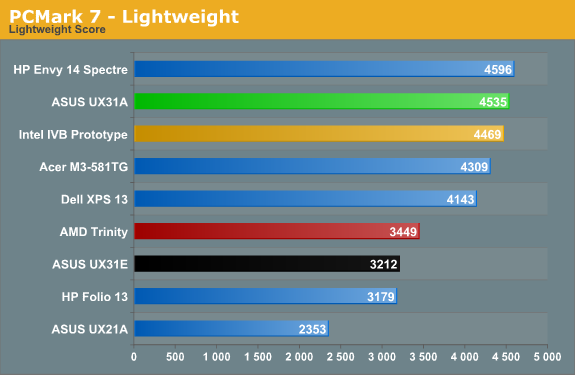

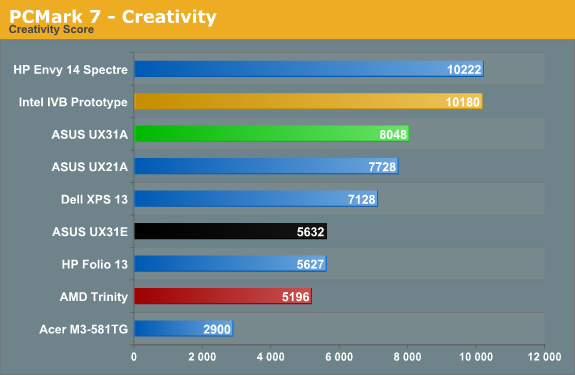
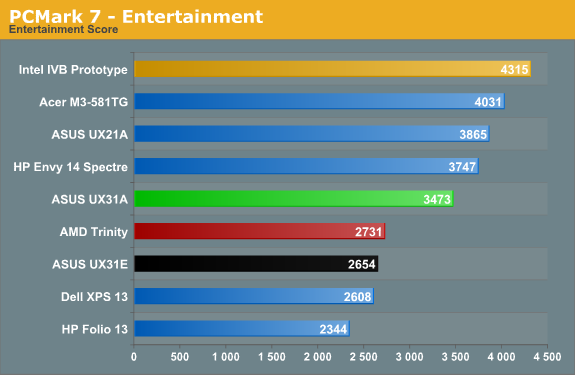
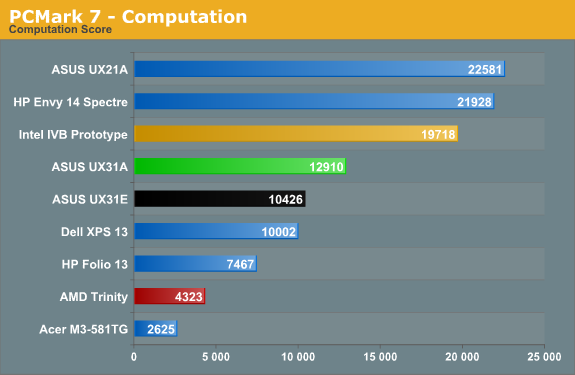
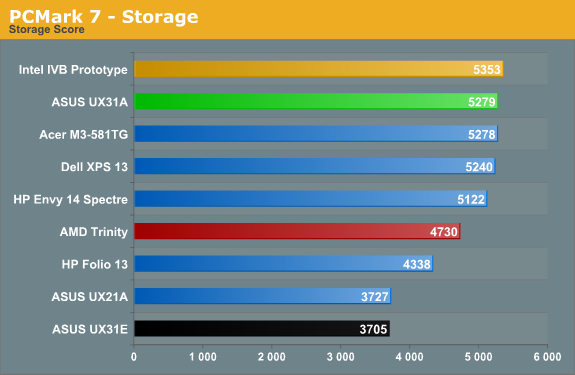
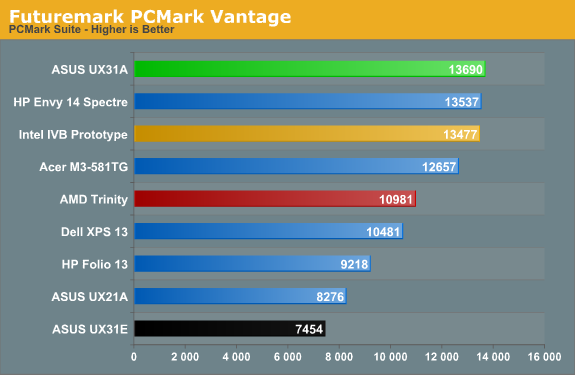
We’re looking at a faster i7-3517U processor compared to the i5-3427U in the last IVB Ultrabook, so naturally some of the scores are higher. PCMark 7 is extremely sensitive to storage performance for most of the tests, and the SF-2281 based SSDs are among the fastest out there (SandForce firmware issues notwithstanding, though I haven’t personally experienced any issues). But if the UX31A sports the fastest ULV processor we’ve tested so far and one of the fastest SSDs, why doesn’t it dominate all of the charts? The problem appears to be with the Intel GPU drivers; other IVB Ultrabooks and laptops have scored in the 20,000+ range in the Computation suite, thanks to Quick Sync, but the UX31A only manages just under 13K. ASUS shipped the UX31A with Intel’s latest 2761 driver set, and while I’ve seen good scores with those drivers I’ve also seen sub-par scores; this appears to be a case of the latter, and it brings down the Computation, Creativity, and Entertainment scores, which in turn affects the overall score as well. Don’t let those minor differences concern you, though: this is right up there with the fastest Ultrabooks.
PCMark Vantage doesn’t utilize Quick Sync, leveling the playing field quite a bit, and you can see that the UX31A tops that chart. Obviously, the difference isn’t all that great, but we wouldn’t expect it to be. The i7-3517U comes with a base clock just 100MHz higher and a max Turbo clock that’s 200MHz higher than the i5-3427U, and as a system benchmark we don’t expect to see that much of a spread in PCMark. Now let’s see what happens with the other benchmarks.
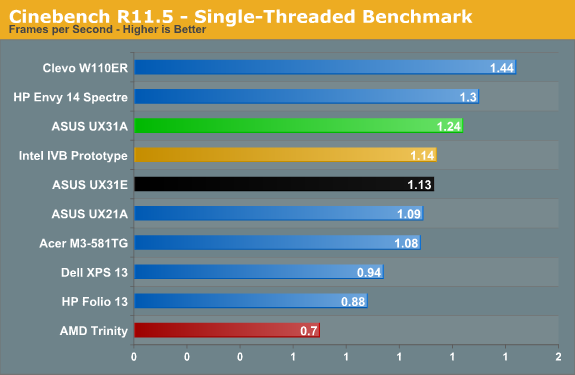
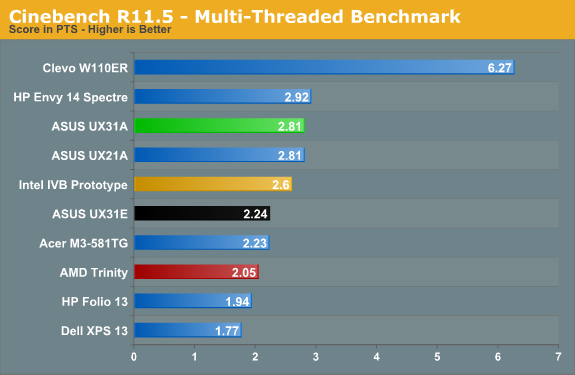
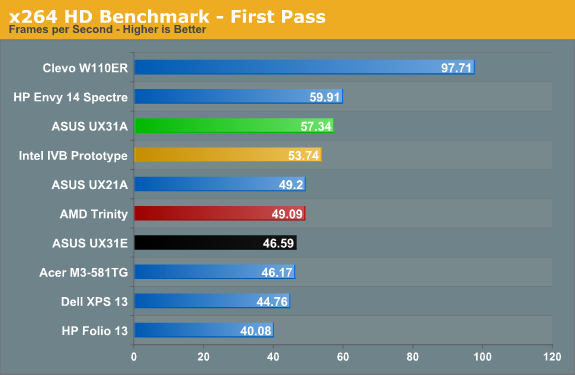
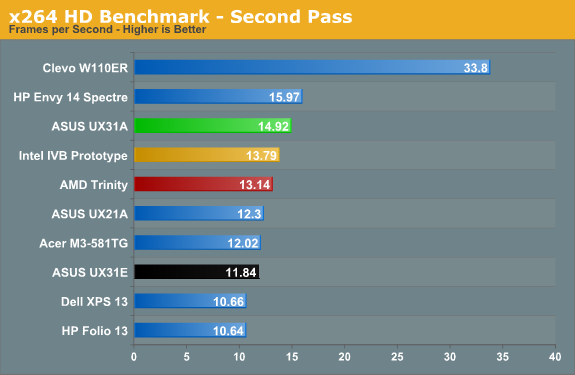
Moving on to the CPU testing side of things, the i7-3517U performs right where you’d expect. A dual-core ULV processor will never match the likes of 45W quad-core Ivy Bridge CPU for raw computational power, but if you’re only doing typical office and Internet related tasks, along with consumption of multimedia, it’s not really a problem. There are definitely applications that will benefit from more CPU performance, but things like 3D rendering (Cinebench) and video editing are only used by a relatively small percentage of users; if you have a desktop in addition to a laptop, that’s likely where you’re going to be doing such tasks. The i7-3517U ends up just slightly faster than the i5-3427U, and there’s really not much of a benefit to the upgrade. Either you can live with ULV performance and the i5 chips, or you’ll need more than the i7 ULV parts can provide.
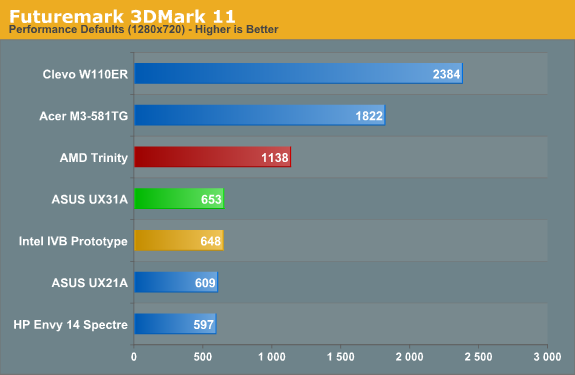
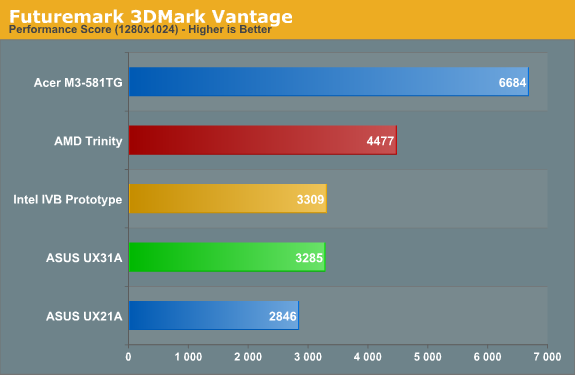
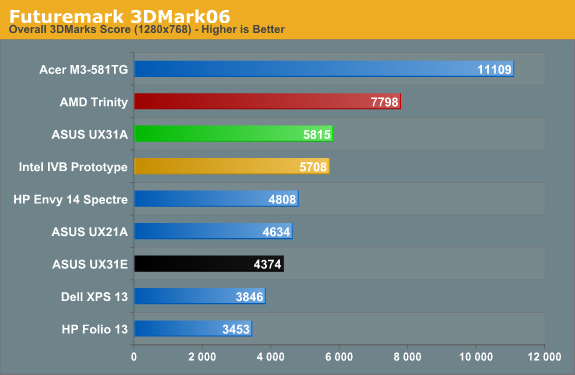
Wrapping up with a quick look at graphics performance, while HD 4000 is certainly a big step up from HD 3000—which in turn was an even bigger step up from Arrandale’s HD Graphics—it’s still nowhere near matching even midrange GPUs like the GT 640M. Ultrabooks are okay for most casual games, but demanding titles will prove too much for the HD 4000, especially when it has to operate within a 17W TDP. If you want an Ultrabook that has a bit more gaming potential, we’d suggest looking at ASUS’ UX32VD (it includes a switchable GT 620M dGPU) or Acer’s updated M5 Ultrabook (with a faster GT 640M LE dGPU). But let’s not base that off of just 3DMark results….










106 Comments
View All Comments
ReverendDC - Tuesday, August 28, 2012 - link
GM failed partially because of "planned obsolescence." Would SSDs not be put into the same category, regardless of how long they last in the end?Tortoise vs hare, in my opinion (as small and non-majority it may be). We are starting to see low-end SSDs coming with only three years or two years of warrenty (thanks for the ever-informative reveiws, guys!). This means that, whether or not they continue to work, they aren't expected to work after 2-3 years. This is definitely inside the range of the average consumer's purchasing cycle, which usually stretches to 4-5 years.
This type of thinking is much more in line with CPUs and RAM, which will be obsolete within 2-3 years and need to be replaced (Moore's Law). Hard drives really haven't changed all that much in 15-20 years, and, really, are similar to the old tape spool drives in how they operate (speaking of tape, it is still used for mass storage...because it is reliable and lasts forever*, although tear-jerkingly slow...).
Just throwing it out there that there is still a (shrinking) contingency that will put up with double the boot times to get better reliablity. Not trying to be a jerk, just offer a different opinion (AND STAY OFF MY LAWN!).
*Forever=your mileage may vary
JarredWalton - Tuesday, August 28, 2012 - link
Just because something is out of warranty doesn't mean it stops working. For the record, I've had five people I know come to me in the past six months with dead/dying hard drives as a problem. Three were on laptops, two were on desktops, and only one drive allowed me to recover data (after putting it in the deep freeze). The oldest drive was around five years, three were less than two years old, and all were out of warranty because they came with an OEM PC (1-year to 3-year warranty).I can't imagine SSDs are really any less reliable than HDDs, which in my experience aren't worth keeping after 3-4 years regardless. They get incredibly loud (bearing noise), fragmentation of files means massive performance degradation, and most consumer drives are now designed to last 3-4 years before all bets are off. In four years, I'm certainly not going to be sad to have to replace a $200 256GB SSD with a $200 1TB+ SSD that will likely run at even higher speeds.
Put another way: when was the last time you even thought about reusing a 3+ year old hard drive in a new PC build? Every time I help someone put together a new PC and they ask, "Can't I just use my old hard drive?" I respond with an emphatic "NO!" Then I explain that technically, yes, they can, but when $70 gets you a modern 1TB drive that will be more reliable and faster, do you really want to use your 4+ year old drive that might fail at any time? If they insist, I usually refer them to someone else, because I won't be responsible for putting together that sort of system and then having to provide support when things go south.
When have you needed to get the data off an old IDE drive where the data wasn't already backed up somewhere else? Even old SATA drives are now retired to the scrap heap (after copying data off, if necessary/possible). If people are keeping drives for 10 years and not backing things up, they're going to lose that data at some point.
SSDs aren't necessarily more reliable in any of these areas, but I've had enough issues with HDDs over the years that I wouldn't trust them as far as I can throw them. HDDs to sail pretty far on a good toss, though.... ;-)
rickon66 - Tuesday, August 28, 2012 - link
Three reasons ultrabooks have not caught on.1. Price
2. Price
3. Price
The mainstream public will not pay the price for an ultrabook, when they see a laptop for $350 sitting next to it. I know the advantages of an ultrabook, but the general citizen does not care enought to pay 3x or 4x the price. It is still somewhat a niche product.
milkod2001 - Tuesday, August 28, 2012 - link
I've read some articles(not on this web) how is Intel going to push prices for Ultrabooks dows to 700-800 level while this one almost doubles it.U'll get nice screen but NoN upgradeable RAM(4GB max) NoN upgradeable SSD...would not pay more then $700 for that, it's just now worth it
I only hope ultrathins based on Trinity will bring some nice alternative because copying Apple designs and asking same money for it is just a bad JOKE
flashbacck - Tuesday, August 28, 2012 - link
It's 2012. Seriously. Why can no one make a frigg'n touchpad that just works?Paedric - Tuesday, August 28, 2012 - link
Sadly, it's probably because of patents.KPOM - Tuesday, August 28, 2012 - link
The ASUS sounds like the top Ultrabook right now. I wonder why they didn't make an 8GB option, though, since it's available in the MacBook Air, and for the most part ASUS has taken its design cues directly from Apple with this particular line. The 1080 IPS screen is a nice touch, and it's good to see that battery life is still pretty good.What does it take to get a Silver or Gold from AnandTech? The top ultraportables (ASUS UX31A and MacBook Air) get Bronze. I think Silver would be well warranted for both. The ASUS has the best screen in the business, and the Air has 8GB RAM and 512GB SSD options.
JarredWalton - Tuesday, August 28, 2012 - link
8GB and a touchpad that doesn't come with any caveats would have been Gold. Each of those items dropped it a notch in my book. The pricing is also somewhat of a factor, as a lot of people are going to shy away from $1400, though the $1030 model DB51 is at least a bit more reasonable.Aikouka - Tuesday, August 28, 2012 - link
You touched on it in your review, but I'd highly recommend that you try installing the Elantech drivers. I have a UX31A-DB51 (128GB SSD variant), and I've been using the Elantech drivers with no problems. Here are my qualms with it though...* The touchpad is too big and it's not recessed. I have the same problems with my Transformer TF300, but the fact that the touchpad is rather large and not recessed means that it's very easy to hit it with your palm while typing. I don't have this problem on my old Dell XPS M1530, because the touchpad isn't that large and it's recessed. Although, it doesn't seem to ever register my palm taps near the top as clicks, which is a good thing. I typed up a few forum posts on it last night, and the worst that I did was move around the cursor a little bit.
* No middle mouse button. I've gotten pretty used to using the left mouse button + right mouse button to act as the middle mouse button. I mostly use it for doing things like closing browser tabs (middle clicking on the tab itself closes it). However, this doesn't work with the UX31, which might be an issue with the Elantech drivers?
* Only has USB 3. This is mostly an issue if you're neurotic like me and refuse to use the default Windows install. Since Windows 7 does not support USB 3 by default, I had to jump through a few hoops just to reinstall Windows and put my drivers on the laptop. However, a fellow forum goer said that turning the USB legacy option to "always on" (instead of "smart") would allow the Ethernet adapter to work. This at least will allow you to download the drivers.
JarredWalton - Tuesday, August 28, 2012 - link
Can you direct me to a link where I can get the Elantech drivers? I commented on this in the review, and I can't find any non-ASUS drivers for Elantech out there. As for middle-click, I put in a request with ASUS to add that functionality.